 W
WThe greater argentine, also known as the Atlantic argentine, great silver smelt, herring smelt or simply smelt, is a northern Atlantic herring smelt and can be found at depths from 140 to 1,440 metres. This species reaches a length of 70.0 centimetres (27.6 in) SL. It is of commercial importance and it is used as seafood.
 W
WBenthosema glaciale, or glacier lantern fish, is the most common species of lanternfish and important part of the midwater ecosystem of northern North Atlantic.
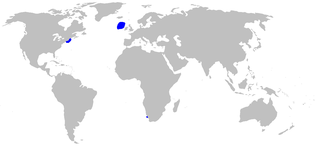 W
WThe ghost catshark is a catshark of the family Scyliorhinidae found on the continental slopes in the northwest Atlantic off Massachusetts, the northeast Atlantic from the Porcupine Bank west of Ireland and the southern Atlantic off Cape Town, at depths between 600 and 1,900 metres.
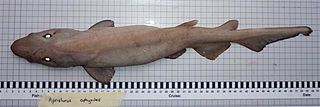 W
WThe white ghost catshark is a shark of the catshark family Scyliorhinidae found in deep water in the northeast Atlantic between latitudes 57°N and 58°N. A deep-water catshark known from the eastern North Atlantic from depths of 1,014 to 1,800 m, it is known from only a limited number of specimens. It reaches a maximum of 54 cm or 1.7 ft total length which is a medium size for the Apristurus genus.
 W
WThe Iceland or Icelandic catshark is a species of catshark, belonging to the family Scyliorhinidae. This catshark is found in the western Atlantic, from Massachusetts, Delaware, and the northern Gulf of Mexico, as well as the eastern Atlantic from Iceland, southwestern Ireland, the Canary Islands, Madeira, South Africa, and between 67 and 11°N. They are found in depths of 550 to 1450 meters near or at the bottom over upper continental slopes.
 W
WThe cusk or tusk is a North Atlantic cod-like fish in the ling family Lotidae. It is the only species in the genus Brosme. Other common names include Tusk, Torsk, European Cusk, Brosmius.
 W
WThe rose fish, also known as the ocean perch, Atlantic redfish, Norway haddock, red perch, red bream, golden redfish or hemdurgan, is a deep sea species of rockfish from the North Atlantic. It is a large, slow-growing, late-maturing fish and the subject of a fishery.
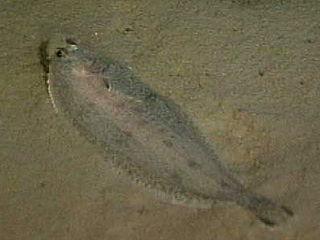 W
WGlyptocephalus cynoglossus, known in English by a variety of common names including the witch, witch flounder, pole flounder, craig fluke, Torbay sole and grey sole, is a species of flatfish from the family Pleuronectidae. It occurs on both sides of the North Atlantic Ocean on muddy sea beds in quite deep water. In northern Europe it has some importance in fisheries as a food fish.
 W
WCouch's goby is a species of goby native to the northeastern Atlantic Ocean as far north as southern Great Britain and Ireland, the Mediterranean Sea and the Adriatic Sea where it can be found living under stones on muddy sand in inshore waters and in the intertidal zone. This species can reach a length of 7.7 centimetres (3.0 in) TL. The specific name and common name both honour Jonathan Couch (1789-1870), the Cornish ichthyologist and the author of A History of the Fishes of the British Islands published between 1862 and 1867.
 W
WMyxine glutinosa, known as the Atlantic hagfish in North America, and often simply as the hagfish in Europe, is a species of jawless fish of the genus Myxine.
 W
WThe Atlantic halibut is a flatfish of the family Pleuronectidae. They are demersal fish living on or near sand, gravel or clay bottoms at depths of between 50 and 2,000 m. The halibut is among the largest teleost (bony) fish in the world, and is an endangered species due to a slow rate of growth and previous overfishing. Halibut are strong swimmers and are able to migrate long distances. Halibut size is not age-specific, but rather tends to follow a cycle related to halibut abundance.
 W
WThe Greenland halibut or Greenland turbot belongs to the family Pleuronectidae, and is the only species of the genus Reinhardtius. It is a predatory fish that mostly ranges at depths between 500 and 1,000 m (1,600–3,300 ft), and is found in the cold northern Atlantic, northern Pacific, and Arctic Oceans. It has a variety of other English vernacular names, including black halibut, blue halibut, lesser halibut, and Newfoundland turbot; while both Newfoundland turbot and Greenland turbot are in common use in North America, these names are typically not used in Europe, where they can cause easy confusion with the true turbot.
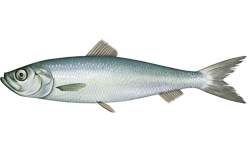 W
WAtlantic herring is a herring in the family Clupeidae. It is one of the most abundant fish species in the world. Atlantic herrings can be found on both sides of the Atlantic Ocean, congregating in large schools. They can grow up to 45 centimetres (18 in) in length and weigh up to 1.1 kilograms (2.4 lb). They feed on copepods, krill and small fish, while their natural predators are seals, whales, cod and other larger fish.
 W
WThe sea lamprey is a parasitic lamprey native to the Northern Hemisphere. It is sometimes referred to as the "vampire fish."
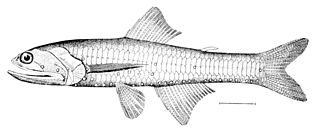 W
WLampanyctus crocodilus, the jewel lanternfish, is a lanternfish of the family Myctophidae, found in west Mediterranean Sea and north Atlantic Ocean. Bathypelagic between 400 and 2000 m.
 W
WThe blue ling is a member of the cod family from the North Atlantic. It is usually 70 to 110 cm long, but the maximum length is 155 cm. Blue ling feed on fish and crustaceans and benthic invertebrates. The fish reaches sexual maturity at the age of six to 12 years.
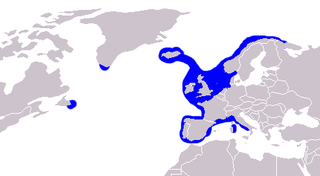 W
WThe common ling, also known as the white ling or simply the ling, is a large member of the family Lotidae, a group of cod-like fishes. It resembles the related rocklings, but it is much larger and has a single barbel. This species is unrelated to the pink ling, Genypterus blacodes, from the Southern Hemisphere. The common ling is found in the northern Atlantic, mainly off Europe, and into the Mediterranean Basin. It is an important quarry species for fisheries, especially in the northeastern Atlantic, although some doubts exist as the sustainability of the fisheries. As an edible species, it is eaten fresh, frozen, or dried, but also preserved in lye, while the roe is a delicacy in Spain.
 W
WThe Atlantic mackerel, also known as Boston mackerel, Norwegian mackerel, Scottish mackerel or just mackerel, is a species of mackerel found in the temperate waters of the Mediterranean Sea, the Black Sea, and the northern Atlantic Ocean, where it is extremely common and occurs in huge shoals in the pelagic zone down to about 200 m (660 ft). It spends the warmer months close to shore and near the ocean surface, appearing along the coast in spring and departing with the arrival of colder weather in the fall and winter months. During the fall and winter, it migrates out into deeper and more southern water, seeking warmer temperatures.
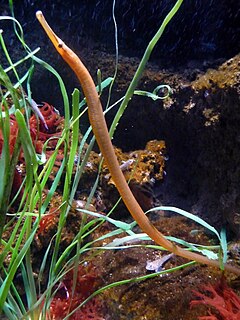 W
WThe snake pipefish is a species of pipefish, from the family Syngnathidae, native to the northeastern Atlantic Ocean where they are generally found amongst algae close in to shore. It is the largest species of pipefish recorded in European waters and has spread into arctic waters in the early 2000s.
 W
WThe American plaice, American sole or long rough dab is a North Atlantic flatfish that belongs, along with other right-eyed flounders, to the family Pleuronectidae. In the northwest Atlantic it ranges from Greenland and Labrador to Rhode Island, and in the northeast Atlantic it ranges from Murmansk to the English Channel, Ireland and Iceland. They live on soft bottoms at depths of 10 to 3,000 m (33–9,843 ft), but mainly between 90 and 250 m (300–820 ft).
 W
WThe saithe is a species of marine fish in the Pollachius genus. Together with Pollachius pollachius, it is generally referred to in the United States as pollock. Other names include the Boston blue, coalfish/coley, and saithe in the UK, the young fish are called podleys in Scotland and northern England.
 W
WThe small-eyed rabbitfish is a species of fish in the family Chimaeridae. It has very wide distribution almost everywhere in Northern Atlantic at depths from 300 to 2,410 m, being most common below 1,000 m. Its total length ranges from 32 to 147 cm. It has a short nose with a blunt tip. The small mouth is located on the lower part of the head and has thick lips. Its back slopes gradually and ends in a fine tail.
 W
WThe fourbeard rockling or four-bearded rockling is a species of lotid fish found in the northern Atlantic Ocean. This species grows to 41 cm (16 in) in total length. It is of minor importance in commercial fisheries.
 W
WThe Atlantic salmon is a species of ray-finned fish in the family Salmonidae which is the largest salmon and can grow up to a meter in length. It is found in the northern Atlantic Ocean and in rivers that flow into this ocean. Most populations of this fish species are anadromous, hatching in streams and rivers but moving out to sea as they grow where they mature, after which the adult fish seasonally move upstream again to spawn.
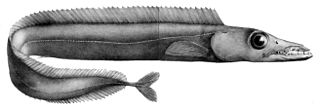 W
WThe black scabbardfish is a bathypelagic cutlassfish of the family Trichiuridae found in the Atlantic Ocean between latitudes 69°N and 27°N at depths between 180 and 1,700 m. Its length is up to 110 cm (3.6 ft), but it reaches maturity around 80 to 85 cm.
 W
WThe American shad is a species of anadromous clupeid fish naturally distributed on the North American coast of the North Atlantic, from Newfoundland to Florida, and as an introduced species on the North Pacific coast. The American shad is not closely related to the other North American shads. Rather, it seems to form a lineage that diverged from a common ancestor of the European taxa before these diversified.
 W
WThe Greenland shark, also known as the gurry shark, grey shark, or by the Kalaallisut name eqalussuaq, is a large shark of the family Somniosidae, closely related to the Pacific and southern sleeper sharks. The distribution of this species is mostly restricted to the waters of the North Atlantic Ocean and Arctic Ocean.
 W
WThe three-spined stickleback is a fish native to most inland coastal waters north of 30°N. It has long been a subject of scientific study for many reasons. It shows great morphological variation throughout its range, ideal for questions about evolution and population genetics. Many populations are anadromous and very tolerant of changes in salinity, a subject of interest to physiologists. It displays elaborate breeding behavior and it can be social making it a popular subject of enquiry in fish ethology and behavioral ecology. Its antipredator adaptations, host-parasite interactions, sensory physiology, reproductive physiology, and endocrinology have also been much studied. Facilitating these studies is the fact that the three-spined stickleback is easy to find in nature and easy to keep in aquaria.
 W
WThe blue whiting, Micromesistius poutassou, one of the two species in the genus Micromesistius in the cod family, is common in the northeast Atlantic Ocean from Morocco to Iceland and Spitsbergen. It also occurs in the northern parts of the Mediterranean, where it may be locally abundant. Blue whiting also occur in the northwest Atlantic Ocean between Canada and Greenland, but is considered rare. It has a long, narrow body and a silvery underbody. The fish can attain a length of more than 40 cm. The average length of blue whiting caught off the west shores of the UK is 31 cm.